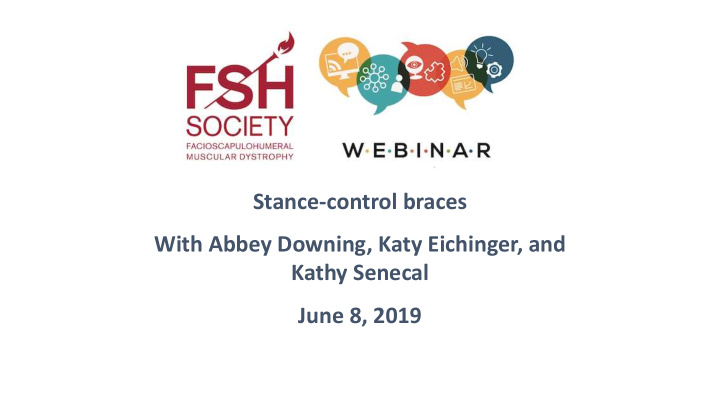



Stance-control braces With Abbey Downing, Katy Eichinger, and Kathy Senecal June 8, 2019
ORTHOTIC MANAGEMENT FOR FSHD Abbey Downing, CPO Saturday June 8, 2019
MUSCULAR PROGRESSION OF CONDITION Weakness affecting initially the face, shoulder, and arms, followed by the distal and then proximal lower extremities later in the disease course. 3
GAIT CYCLE AND INVOLVEMENT OF KNEE During normal walking, the knee is continuously moving from extension to flexion (and repeated) throughout the entire gait cycle. Gait cycle begins again 4
OBSTACLES ASSOCIATED WITH LOSS OF QUADRICEP FUNCTION • Increase in falls • Decrease in mobility • Decrease in independence • Increase in overuse conditions
6
ORTHOTIC OPTIONS TO PREVENT KNEE BUCKLING • Methods to mechanically lock the knee have been around for hundreds of years. o Locked o Unlocked o Offset alignment • Most recent methods to stabilize the knee o Automatic lock/unlock (Stance Control) o Computer regulated stance and swing controlled orthosis (SSCO) 7
LOCKED KNEE ORTHOSIS • Advantages o Highly Stability o Facilitate Mobility • Disadvantages o Uses a lot of energy to walk o Changes to gait pattern/deviations o Functionally longer affected limb o Secondary medical complications due to compensatory motions and excessive “wear and tear” of joints on the other leg 8
EFFECTS OF A LOCKED KNEE DURING GAIT 9
EFFECTS OF LOCKED KAFOS ON USER PHYSIOLOGY • Increased pulmonary stress Heart rate • Increased cardiac stress Locked Knee joint • SCO •
ALTERNATE OPTION FOR ORTHOTIC KNEE JOINT • Free motion joint with posterior offset o Advantages o No actual lock o Obtain stability through alignment o Easy to put on o Disadvantages o Can be unpredictable o Knee can still buckle o Will most likely still require support from assistive device
INTRODUCTION OF STANCE CONTROL DEVICES ORTHOSIS THAT AUTOMATICALLY LOCK AND UNLOCK Benefits: • o Allowing free knee motion during the swing phase increases gait efficiency o Allowing free knee motion during the swing phase decreases energy cost Studies: • o “Effects of the Stance Control Orthosis on Functional Walking Abilities and Heart Rate Response.” Amy Gross McMillan, PT, PHD, et al. o “The energy expenditure of normal and pathologic gait.” Robert Waters, MD o “Energy-Efficient Knee-Ankle Foot Orthosis: A Case Study.” Kenton Kaufman PhD, et al.
STANCE CONTROL DEVICES • ADVANTAGES o ALLOW FOR MORE NORMAL WALKING PATTERN o PROVIDE LOCK WHEN FOOT IN CONTACT WITH GROUND o DECREASES CARDIAC & PULMONARY STRESS o DISADVANTAGES o REQUIRE PRACTICE AND PHYSICAL THERAPY o MECHANICAL- SEVERAL MOVING PARTS o COVER ENTIRE LEG
15
16
HOW DO STANCE CONTROL DEVICES WORK? • GAIT ACTIVATED o CAN BE USED WITHOUT FOOT SECTION o ANKLE ACTIVATED o SOME OF THE LIGHTEST WEIGHT OPTIONS (~2 LBS) o WEIGHT ACTIVATED o NO CURRENT OPTIONS IN UNITED STATES 17
OBSTACES TO OVERCOME • NEED FOR PHYSICAL THERAPY/TRAINING o SOCIAL IMPLICATIONS o EMOTIONAL/MENTAL IMPACT o WILLINGNESS TO WEAR LONG LEG BRACE 18
CONCLUSION • STANCE CONTROL BRACES CAN INCREASE SAFETY AND MOBILITY o SUCESSFUL USAGE REQUIRES WILLINGNESS TO PARTCIPATE IN THERAPY AND A KNOWLEDGABLE CLINICIAN o ABBEY DOWNING, CPO o HANGER CLINIC o WETHERSFIELD, CT o 860-529-3350 o ADOWNING@HANGER.COM 19
Recommend
More recommend